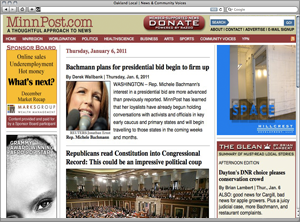Kramer gives his writers more editorial freedom than they might have at a newspaper. “We encourage writers to combine reporting with analysis and even commentary based on their own experience and expertise,” he says. Leaving complete coverage to larger outfits, MinnPost is aggressively Minnesota-centric and hard news oriented. A typical front page might cover the presidential aspirations of Senator Michele Bachmann, how a digital bible-study tools, how the Twin Cities are integrating new immigrants, and the local burglary rate. There’s a special emphasis on the real world effects of politics and policy. At one point, advertisements for the site read “NO Britney, NO Paris, NO Lindsay.”
MinnPost has an editorial staff of five, a handful of business and technology employees, and fifteen writers who write either full-time or freelance regularly. This includes a Washington, D.C. correspondent who delivers a Minnesota take on Congress. MinnPost editors study readership metrics from Google Analytics and sites like Quantcast, and they often ask readers for feedback. While freelancers wrote the majority of articles in MinnPost’s early days, research revealed that readers preferred to develop a relationship with writers who appear on the site on a regular basis, so Kramer hired more full-timers.
MinnPost seeks to become self-sustaining by 2012 by combining NPR-style donations and memberships with ad dollars. The site is experimenting with all manners of generating income, but Kramer boils their efforts down to three main revenue sources: donations and grants, local advertisements, and a yearly fundraising event called MinnRoast, which brings in about $100,000. New revenue models have been a key part of MinnPost’s success. The site lets corporations sponsor sections or columnists, and a new system called “Real-Time Ads” allows advertisers to flash their Facebook status or Twitter feed on MinnPost, ideally connecting local readers with up to the minute information about events or, say, a restaurant’s daily specials.
MinnPost accepts network ad sales, but an old-fashioned sales staff generates 90 percent of ad revenue. A cornerstone of Kramer’s revenue model is that the site cares more about loyal readers than total traffic. This allows him to charge slightly higher CPMs to local businesses, and he says it has improved click-through rates. Loyal readers are also more likely to donate, and Kramer hopes their dollars will be an important piece of the revenue pie as 2012 approaches.
 MINNEAPOLIS, MINNESOTA — Harvard’s Nieman Journalism Lab calls MinnPost founder Joel Kramer “one of the brightest stars in the news-startup firmament.” The former editor and publisher of the Minneapolis Star Tribune, Kramer started his nonprofit in 2007 with a rolodex of veteran journalists to whom he offered freelance work, and $1.2 million dollars in commitments from foundations and private donors. This was only a year’s worth of funding, half of what Kramer wanted to raise, but he decided not to wait. MinnPost is now a significant player in an educated, news hungry Twin Cities market.
MINNEAPOLIS, MINNESOTA — Harvard’s Nieman Journalism Lab calls MinnPost founder Joel Kramer “one of the brightest stars in the news-startup firmament.” The former editor and publisher of the Minneapolis Star Tribune, Kramer started his nonprofit in 2007 with a rolodex of veteran journalists to whom he offered freelance work, and $1.2 million dollars in commitments from foundations and private donors. This was only a year’s worth of funding, half of what Kramer wanted to raise, but he decided not to wait. MinnPost is now a significant player in an educated, news hungry Twin Cities market.
